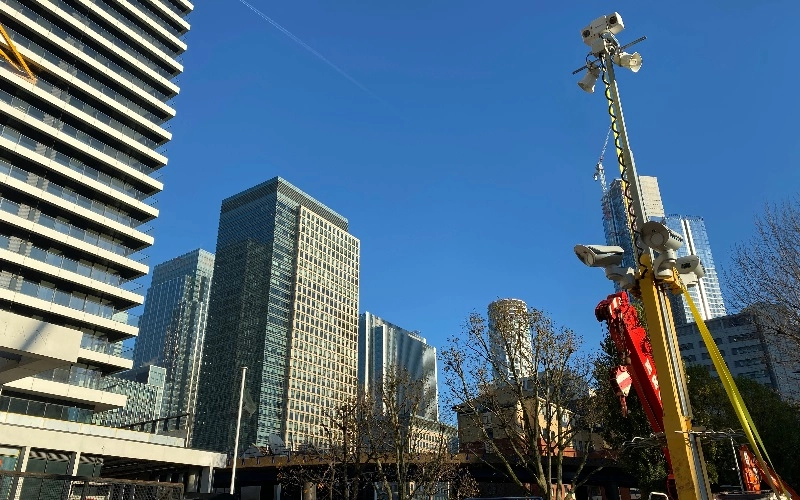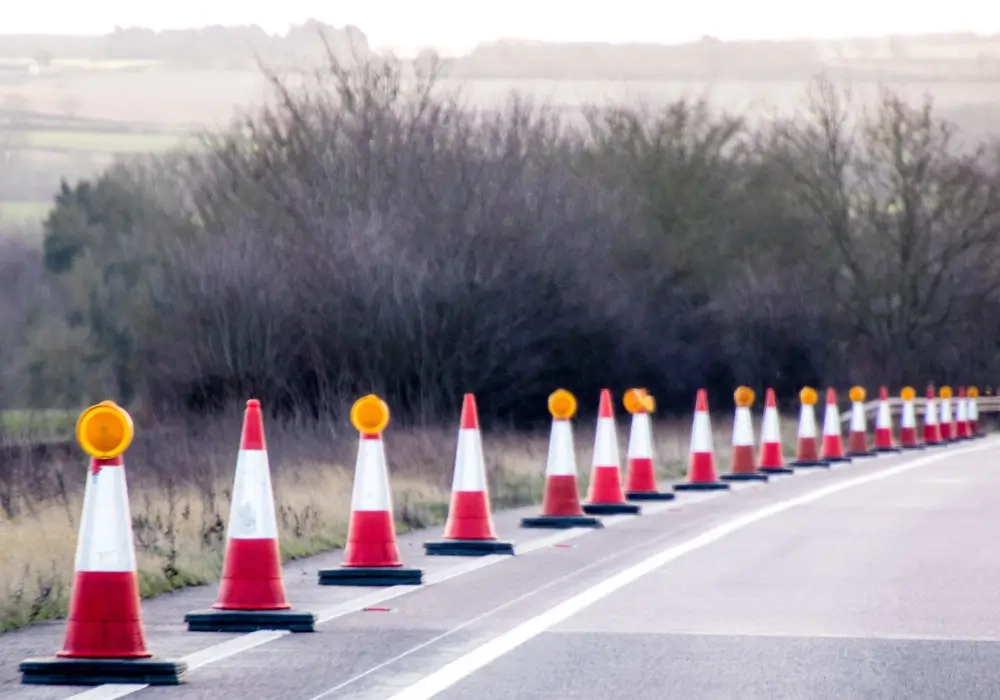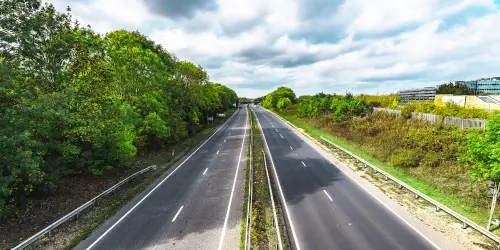Roadworks, maintenance projects and highway upgrades are ongoing necessities for keeping the UK's road network safe and functional. But they also create temporary disruptions that require careful planning and control.
Temporary Traffic Management (TTM) is the system that keeps everyone safe. It protects road users, workers, cyclists and pedestrians while maintaining safe traffic flow through work zones. Cones, barriers and signage form the basics, but effective traffic control measures go much further.
In this guide, we'll give you a complete temporary traffic management overview and explain why integrating security in your traffic management plan matters.
What is Temporary Traffic Management (TTM)?
Temporary Traffic Management is the process of planning, designing and implementing traffic control measures during roadworks, construction, maintenance activities or events along UK roads. Simply put, it keeps road users and workers safe while minimising disruption to traffic flow.
TTM uses various traffic control devices, signage and trained personnel to manage traffic flow and pedestrians through high-speed roadworks safely.
In the UK, an effective traffic management plan must comply with strict regulations outlined in the Department for Transport's Traffic Signs Manual and Highways England's GG116 standards (England only). These guidelines ensure safe practices across all short-term lane closures (STC) and diversions.
Key elements of effective Temporary Traffic Management
-
Planning: A thorough risk assessment identifies potential hazards and sets out the right control measures for safe road or lane closures and diversions. This looks at traffic volumes, road layouts, project duration and the specific risks faced by both workers and road users, particularly on high-speed dual carriageways where vehicles can reach 70mph.
-
Site layout design: Outlines the location and configuration of work zones, including lane closures, diversions and access points. Effective planning and design consider the size and type of vehicles using the road, pedestrian crossings, cycle lanes and nearby intersections.
-
Communication: Local authorities, highway teams and contractors work together to develop safety strategies and communicate them clearly with the public using warnings, traffic signals, signs and media updates. This helps maintain a safe and efficient flow of traffic while protecting road users, event-goers and workers.
-
Traffic control devices: Physical traffic management measures help guide road users safely through construction zones. Common devices include cones, barriers, "stop-go" controls, detour signs and reduced speed limit signs. Advanced technologies such as smart detection systems and mobile CCTV Towers are also being deployed to enhance safety and efficiency in temporary traffic situations.
Why Security Matters in Temporary Traffic Management
Here are 6 reasons why advanced security matters in effective traffic management plans:
1. Keeps road users and workers safe
Road workers face serious risks while working on or close to moving traffic, ranging from collisions and anti-social behaviour from drivers to unauthorised access from trespassers and intruders.
Temporary CCTV surveillance delivers workforce safety, evidence capture and incident response on active roads, lane closures, diversion routes and roadside work zones. These smart systems help identify and mitigate potential threats before they turn into serious issues.
Our Traffic Management Towers stand up to 6 metres tall, delivering near-360° coverage for highway projects. Their visibility acts as a strong deterrent to intruders, while 24/7 remote monitoring ensures genuine threats are identified in real-time. From there, alerts are sent to mobile keyholding teams and emergency services to investigate where necessary.
Read more: Why Traditional Security Fails on High‑Speed Roadworks (And What Works Instead)

2. Reduces accidents and injuries
Advanced surveillance systems equipped with PTZ (Pan-Tilt-Zoom) cameras and AI-video analytics detect stopped vehicles, unauthorised access, driver behaviour and dangerous obstructions in work zones. This real-time detection enables rapid response to potential incidents, significantly reducing the likelihood of traffic accidents and injuries.
AI-powered systems use machine learning to detect unusual activity and trigger instant alerts when things don't look "normal". This gives local authorities, transport teams, contractors and traffic controllers the chance to act before incidents escalate.
With features like ANPR (Automatic Number Plate Recognition), thermal imaging and infrared (IR) night vision, these systems also capture vehicle details and maintain visibility in low-light conditions, keeping road users, workers, sites and assets protected both day and night.
Read more:
- AI-Powered Detection on High-Speed Roads
- How Artificial Intelligence is Revolutionising CCTV Tower Monitoring
3. Provides clear guidance around construction sites
Visible traffic management measures reinforce the seriousness of site restrictions and help prevent public confusion. Bright yellow CCTV Towers serve as a psychological deterrent and visual reminder that areas are monitored and restricted. This in itself encourages compliance with diversions, surveillance and signage adherence along motorways.
Additional security tools like Body Cameras worn by workers and traffic controllers help reduce verbal and physical abuse towards public-facing staff. They also capture clear footage needed for police investigations and insurance claims, and protect teams from false accusations.
4. Reduces traffic disruptions and delays
CCTV surveillance systems help control traffic flow by preventing unauthorised access that could lead to serious delays. By securing major highway schemes and/or short-term roadwork projects, they help manage risk and keep operations on schedule.
ANPR tools further enhance control by tracking vehicle movements through work zones and flagging suspicious behaviour in real-time. Combined with remote monitoring, this allows for rapid response to incidents before they worsen, minimising congestion and keeping motorways functional during closures and diversions.
5. Protects assets and supports critical infrastructure maintenance
Long-term highway projects require secure environments for both workers and valuable equipment. Theft of machinery, traffic control devices and construction materials can cause costly delays and disrupt street work timelines.
Temporary CCTV solutions offer flexible security that adapts as sites move or evolve, ensuring assets are protected from start to finish. This level of protection is vital for keeping critical road upgrades on track and safeguarding equipment. Strong [security specifications] also strengthen traffic management proposals/tenders, giving contractors a competitive advantage.
6. Supports compliance and ESG reporting
UK road projects must comply with strict environmental and regulatory requirements. Using professional CCTV systems with GDPR-compliant data handling, secure storage and eco-friendly power options (such as solar or hybrid setups) not only ensures compliance but also reduces the risk of fines and reputational damage.
When paired with advanced IoT-based sensors, these systems go a step further by helping contractors demonstrate due diligence and meet these obligations.
Our CCTV solutions can integrate environmental monitoring sensors to track air quality, dust, CO₂, noise levels, vibrations and weather conditions in real-time. This data supports Section 61 compliance for UK construction sites near urban areas and provides transparent evidence for ESG reporting.
Read more: Enhancing CCTV Towers with Site Monitoring Sensors
How Integrated Surveillance Enhances Traffic Management Security
Integrating mobile CCTV Tower surveillance with traffic control measures creates airtight protection for highway and carriageway projects. Our Traffic Management Towers are purpose-built for these environments, offering:
-
Rapid deployment: Basic setups can be installed within 20 minutes, providing immediate coverage as work zones move along motorway routes.
-
Autonomous operation: Running on a mix of solar power and fuel cell batteries, our Traffic Management Towers operate for up to 20 weeks between charges. This makes them ideal for roadworks in remote locations where mains power and Wi-Fi are limited or unavailable.
-
AI-powered incident detection: Equipped with intelligent software and AI analytics, these systems identify stopped vehicles and wrong-way drivers and monitor lane closures with near pinpoint accuracy, preventing incidents before they escalate.
-
Remote monitoring and rapid response: Our surveillance systems include 24/7 remote monitoring by NSI Gold Accredited centres and a fully-managed service as standard. When threats are detected, trained personnel issue quick actions such as live voice-down audio challenges, siren activation or dispatch of mobile keyholding teams.
-
Centralised management platform: Our Stellifii platform provides centralised control over multiple CCTV Towers across large street work projects. Site managers and local authorities can review footage in real-time, check system status and generate reports from any device.
Implement Temporary Traffic Management Solutions the Smart Way
Temporary Traffic Management (TTM) keeps construction and maintenance projects moving safely and efficiently with minimum disruption for drivers, pedestrians and workers.
By combining proven TTM strategies with advanced surveillance systems, like mobile CCTV Towers, you can enhance safety, cut costs and reduce risks.
With 6 regional hubs and over 20-years of experience in wireless security, we understand the unique challenges of highway security. Our Traffic Management Towers deliver professional-grade monitoring at up to 88% lower cost than traditional security guards.
Manage traffic the smart way. Contact our security experts to discuss your needs today.
FAQs
Who is responsible for implementing TTM in the UK?
TTM designers are responsible for planning and designing effective traffic management plans. Project managers, traffic engineers, traffic controllers and road workers all play roles in implementing and managing TTM operations.
How long does it take to set up traffic management CCTV?
Our basic Traffic Management CCTV Towers can be installed within 20 minutes, providing immediate security coverage for highway projects. More complex multi-camera configurations may require longer setup times depending on site requirements.




